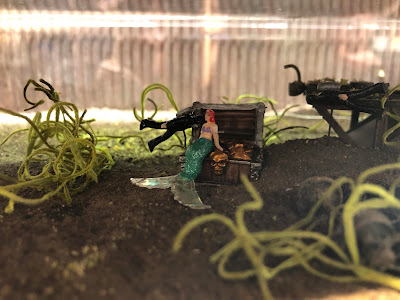
Our neighbor Bob Wickham is a skilled ship model builder, and he recently volunteered to assemble the Walthers tugboat kit and customize it for the MILW tug that once plied the waters of Puget Sound. I had already built the car float kit many years ago, although it's not an exact replica of the ones the MILW used in Seattle, and as you can see it is too long for the "water" available for it. As you can see, he did a great job on the tug, adding a steam engine style stack and building brass hand rails to replace the silly-looking square plastic handrails that come with kits like that. We haven't gotten it tied up to either the apron (built by Dave Enger a few months ago (just in time!)) or the car barge, but as you can see from the ropes draped on the aft deck, it won't be long.
While he was at it, he also painted the barge a dark grey, and then I put some pan pastel on the rails and vents, and some yellow Floquil on the cleats and bollards. It's amazing how much better it looks now than the original bare plastic did!
As you can see from the second photo, I didn't have room for the Walthers apron (which was based on a NYC prototype anyway), so I built a flexible section of track and attached it to an O scale Caboose Industries ground throw, which has enough movement to switch between tracks left and center. But one of these days I'll rip that out and install switchpoints instead, a much more prototypical and elegant solution. This was just easier and quicker. The famous wooden overhead infrastructure of the MILW slip at Pier 27 would be cool to have here, too, but I don't see where I have room for it, so far. Maybe some year someone will 3D print this and I'll figure a way to modify the front fascia to make room for it.
The capacity of this car float is something like 16 cars, practically a full trainload, but so far in op sessions we've only managed to move half that amount back and forth to the pier. Partly there aren't enough waybills sending cars to Port Angeles, and partly the layout is mainly a BN affair, so getting someone to operate the MILW switcher is sometimes a low priority if we don't have enough operators. Also, my model of Argo yard is so small that 16 car would overwhelm it anyways.
The next phase of the car barge project will be building another, shorter, float to carry cars to Victoria BC, something that the MILW also did from Seattle. Cal Sexsmith wrote a wonderful article about this in one of last year's OPSIG "The Dispatcher's Office" journals, and I am really looking forward to figuring out how to integrate that into our operations. Argo's small size notwithstanding.
Here's another overview shot of the scene so far. Notice how well the see-through water effect in front of the tug works, and this is even before I try coloring or texturing it. The bronze propellor load was also contributed by neighbor Bob - he didn't need these props, so he put them on a surplus flat car with some tie down chains, and voila!:
This post would not be complete without a peek underwater. Eric Vannice recently completed installing a mermaid down there, guarding a couple of large treasure chests from some interested divers groping around between some derelict cars that had fallen off the barge. It's hard to see in the dark, but it's there...















